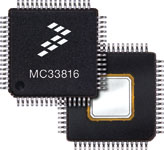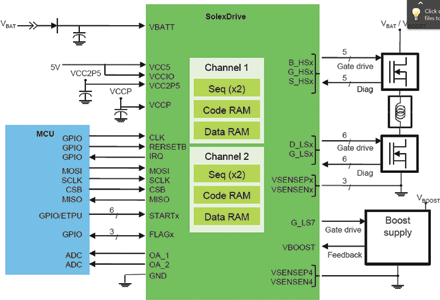
A chip initially developed by Freescale Semiconductor (in partnership with two large companies operating in the field of automotive technology) for high-precision control of actuator coils is now available from EBV Elektronik under the name SolexDrive.

The aim behind the development of SolexDrive was to create the best possible IC for controlling injection nozzles for diesel and petrol engines with exceptionally low emissions. In this automotive application, the chip drives external MOSFETs, which in turn are connected to the injectors. These injectors are essentially actuator coils that function to the very highest precision.
Seeing the promise of this technology for industrial applications as well as the highly specialised automotive application it was designed for, EBV adopted the device into its EBVchip family to target the market demand for switches designed to control high-precision actuator coils.
In many applications, it is often only possible to set a valve to ON or OFF, making precise dosing extremely hard to achieve. Particularly when digital ON/OFF controllers are switched off, a small amount of the dosed substance (e.g. water or technical gas) can still very easily leak through the valve. This can lead to either inaccurate dosing or unnecessary wear, which result in extra costs or over-stretching of resources. Continuous controllers enable more precise regulation.

SolexDrive’s high-precision pulse-width modulation enables accurate control of the coil. Depending on the application, this could involve the control of a linear coil or a speed controller motor in DC brush motors. Combining precision control with high-side or low-side drivers, this solution opens up a range of opportunities.
Except in emergencies, valves do not generally need to be adjusted especially quickly. But it is precisely when valves are adjusted at speed – such as in the case of digital ON/OFF controllers – that the coil is exposed to high currents.
These very high inrush currents can lead to a number of switching-related problems: not only do the control components – including their protective circuits – have to be sufficiently high-dimension, but the high currents also lead to considerable EMC problems. Furthermore, these high inrush currents result in high (and unnecessary) energy consumption, sometimes even requiring compensation.
These very high currents and reverse/counter currents to which the actuator coils are exposed when a digital ON/OFF controller is used place extreme stress on these components, with the result that they need to be replaced relatively frequently during operation.
With SolexDrive, these high current peaks can be avoided thanks to a continuous PWM controller. This reduces EMC-related stress, while at the same time enhancing precision and increasing the lifetime of the actuator coils as the problems caused by sparks are reduced.
Typical applications for the new chip include robots equipped with multiple actuators as well as a host of other applications in which coils need to be controlled electronically – from filling stations to medical equipment; wherever drivers are required for actuator coils, valves, inductive position actuators, liquid and gas regulators, industrial flow meters, distributed ventilation controllers, linear actuators, professional sprinkler systems in horticulture and so on.
Although not all applications require the full, complex functionality that the component offers, EBV believes it can still prove highly useful because it takes up less room on circuit boards and offers greater reliability thanks to its protective and diagnostic circuits.
In addition to the automotive sector, SolexDrive can potentially be deployed in a range of other applications where engines require a higher level of efficiency. Examples include nautical applications, boots, snowmobiles, commercial vehicles, motorcycles and construction and agricultural machinery.
According to EBV, the chip’s attractive price also makes it suitable for controlling relays for which a feedback or diagnostic signal and a corresponding protective circuit are required. In these applications, it reduces not only the electrical stress on the relay, but also the inrush currents. SolexDrive can be used to control up to 11 relays simultaneously: five in a high-side and six in a low-side configuration.
SolexDrive functions with two independent channels, each of which contains two micro-cores which are basic microcontrollers which can operate independently of each other. This means, for example, that four completely different and independent sequences for controlling the injectors in a four- or six-cylinder engine can be programmed.
The micro-cores operate independently and control the pulse-width-modulated driver current with 65 535 different values. SolexDrive receives the relevant target value as a 16-bit value via an SPI interface from a standard microcontroller such as that commonly found in engine control units. From this signal, the chip then generates the appropriate pulse-width-modulated driver sequences for controlling the MOSFETs.
SolexDrive can drive five high-side drivers with five diagnostics cables and six low-side drivers with six diagnostics cables. The micro-cores are RAM-type only, meaning that the code has to be loaded to the RAM during initialisation, while there is also the option of changing the parameters dynamically.
The integrated micro-cores perform all control tasks in real time throughout the entire operating time: from OFF to the boost phase, adjustment in line with the peak value and peak decay. It also dynamically maintains the hold state up to hold decay and back to the OFF state.
Different maximum and minimum values can be defined throughout all of these phases. The micro-core ensures that these values are maintained, for example by continuously comparing the actual values with individually pre-programmed peak ON/OFF targets, hold ON/OFF targets as well as various timing parameters.
As a result, developers need not worry about this complex procedure, but must simply ensure that the microcontroller supplies the relevant current and timing specifications to SolexDrive via the SPI interface. The EBVchip takes care of the rest by adjusting the currents in line with the behaviour of the individual actuator coils.
The PWM current pulse sent to the actuator begins on the rising slope of the trigger signal of the microcontroller and terminates on the falling slope of this signal. SolexDrive measures the current actually flowing through the coils, which means that precise feedback from the coil circuit is available. The IC also features the necessary protective circuits with the associated diagnostic functions.
A crossbar switch integrated on the chip allows developers to assign the individual channels to one of the four integrated sequencers, which enables SolexDrive to serve different channels with a single sequencer.
The chip also features a DC/DC converter to enable the control of high-side MOSFETs, which require a higher voltage on the gate than on the source. As a result, the MOSFETs can then – with the obligatory free-wheeling diode – all be connected directly to the IC output; the necessary protective circuits are also already integrated into SolexDrive.
The chip provides pulse-width-modulated signals of up to 100 kHz at its output, thereby controlling MOSFETs requiring a charge of 30 nC (maximum 50 nC).
For more information contact EBV Electrolink, +27 (0)21 402 1940, [email protected], www.ebv.com
| Tel: | +27 11 236 1900 |
| Email: | [email protected] |
| www: | www.ebv.com |
| Articles: | More information and articles about EBV Electrolink |

© Technews Publishing (Pty) Ltd | All Rights Reserved